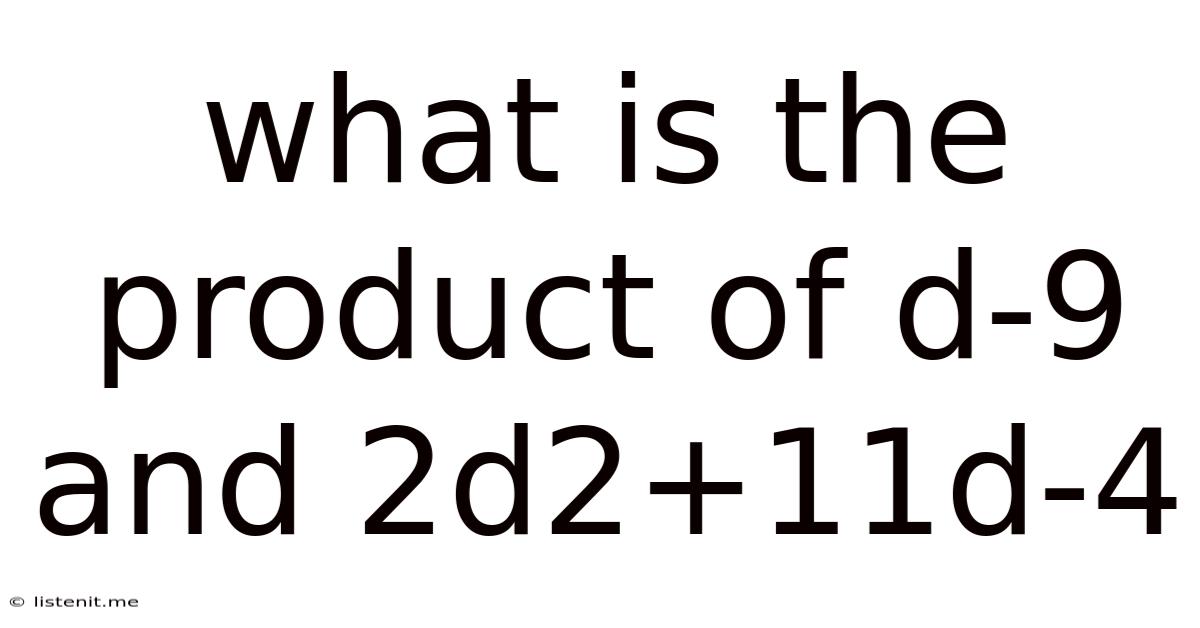What Is The Product Of D-9 And 2d2+11d-4
listenit
May 12, 2025 · 4 min read

Table of Contents
What is the Product of d² - 9 and 2d² + 11d - 4? A Comprehensive Guide to Polynomial Multiplication
Polynomial multiplication is a fundamental concept in algebra. Understanding how to multiply polynomials efficiently and accurately is crucial for success in various mathematical fields and applications. This article will provide a step-by-step guide to multiplying the polynomials (d² - 9) and (2d² + 11d - 4), explaining the process, common pitfalls, and practical applications. We'll also delve into the significance of this specific calculation and explore related algebraic concepts.
Understanding Polynomial Multiplication
Before we dive into the specific problem, let's review the basics of polynomial multiplication. Polynomials are algebraic expressions consisting of variables (like 'd' in our case) and coefficients, combined using addition, subtraction, and multiplication. Multiplying polynomials involves applying the distributive property (also known as the FOIL method for binomials). The distributive property states that for any numbers a, b, and c: a(b + c) = ab + ac. When multiplying polynomials, we distribute each term of the first polynomial to every term of the second polynomial.
The FOIL Method (for Binomials): A Quick Recap
While the FOIL method is specifically for multiplying two binomials (polynomials with two terms), it's a helpful visual aid to understand the underlying principle. FOIL stands for:
- First: Multiply the first terms of each binomial.
- Outer: Multiply the outer terms of each binomial.
- Inner: Multiply the inner terms of each binomial.
- Last: Multiply the last terms of each binomial.
Then, combine like terms to simplify the resulting expression.
Multiplying (d² - 9) and (2d² + 11d - 4)
Now, let's tackle the problem: finding the product of (d² - 9) and (2d² + 11d - 4). Since we're dealing with a binomial and a trinomial (a polynomial with three terms), we'll extend the distributive property to handle this case. We'll multiply each term in the first polynomial (d² - 9) by each term in the second polynomial (2d² + 11d - 4).
Step 1: Distribute d²
- d²(2d²) = 2d⁴
- d²(11d) = 11d³
- d²(-4) = -4d²
Step 2: Distribute -9
- -9(2d²) = -18d²
- -9(11d) = -99d
- -9(-4) = 36
Step 3: Combine Like Terms
Now, we combine the terms from Steps 1 and 2 that have the same variable and exponent:
2d⁴ + 11d³ + (-4d²) + (-18d²) + (-99d) + 36
Simplifying, we get:
2d⁴ + 11d³ - 22d² - 99d + 36
Therefore, the product of (d² - 9) and (2d² + 11d - 4) is 2d⁴ + 11d³ - 22d² - 99d + 36.
Verifying the Result
While the above steps are straightforward, verifying our answer is always a good practice. One way to do this is by using an online polynomial calculator or symbolic algebra software. However, these tools don’t necessarily build your algebraic understanding. It’s better to work through the process manually to reinforce your understanding of the principles involved.
Another approach to verify the result, albeit more advanced, would be to use specific numerical values for 'd' in both the original expression and the simplified result. Substitute the value, and if both expressions produce the same outcome, it offers strong evidence, though not definitive proof, that your multiplication is correct.
Practical Applications of Polynomial Multiplication
Polynomial multiplication isn't just an abstract mathematical exercise. It has numerous practical applications across various fields:
- Calculus: Polynomial multiplication is fundamental to calculus operations such as differentiation and integration.
- Physics and Engineering: Many physical phenomena are modeled using polynomials. For example, calculating projectile motion or analyzing the behavior of circuits might involve polynomial multiplication.
- Computer Graphics: Creating curves and shapes in computer graphics frequently uses polynomial equations, and understanding their manipulation is key.
- Economics and Finance: Polynomial functions are used to model economic growth, investment strategies, and various financial models.
- Data Science and Machine Learning: Polynomial regression, a technique that models data using polynomials, relies heavily on polynomial manipulation.
Further Exploration: Factoring Polynomials
The reverse process of polynomial multiplication is polynomial factoring. Factoring involves breaking down a polynomial into simpler expressions that, when multiplied, give the original polynomial. Our result, 2d⁴ + 11d³ - 22d² - 99d + 36, can potentially be factored, although it might not be easily factored into simple expressions. Factoring is a valuable skill in simplifying expressions and solving polynomial equations.
Conclusion: Mastering Polynomial Multiplication
Mastering polynomial multiplication is a cornerstone of algebraic proficiency. Understanding the process thoroughly, from the distributive property to combining like terms, is essential for tackling more complex mathematical problems. This detailed guide has walked you through the multiplication of (d² - 9) and (2d² + 11d - 4), providing a step-by-step solution and highlighting its practical relevance. Remember that consistent practice and a solid grasp of the fundamental principles are key to success in algebra and related fields. By understanding the process, you not only solve this specific problem but equip yourself with a powerful tool for future mathematical endeavors. Continue practicing, explore further algebraic concepts, and watch your mathematical skills flourish!
Latest Posts
Latest Posts
-
What Is The Square Root Of 146
May 13, 2025
-
What Is 25 In Simplest Form
May 13, 2025
-
4 X 3 2x 6 X 2
May 13, 2025
-
When Solutions Of Nacl And Agno3 Are Mixed
May 13, 2025
-
How Do You Calculate The Mass Of A Liquid
May 13, 2025
Related Post
Thank you for visiting our website which covers about What Is The Product Of D-9 And 2d2+11d-4 . We hope the information provided has been useful to you. Feel free to contact us if you have any questions or need further assistance. See you next time and don't miss to bookmark.